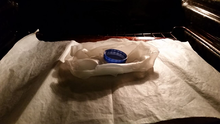HDPE Processing: Difference between revisions
Jump to navigation
Jump to search
mNo edit summary |
mNo edit summary |
||
| (4 intermediate revisions by the same user not shown) | |||
| Line 2: | Line 2: | ||
[[Category:Michael's Projects]] | [[Category:Michael's Projects]] | ||
[[Category:Reusing]] | [[Category:Reusing]] | ||
{{Project | {{Project | ||
|image=File:Hdpe-proc-bottle-melt-1.png | |||
|name=HDPE Processing | |name=HDPE Processing | ||
|primary=[[User:Msemtd|Michael Erskine]] | |primary=[[User:Msemtd|Michael Erskine]] | ||
|status= | |created=23/10/2015 | ||
|status=Complete | |||
|type=member | |||
}} | }} | ||
HDPE block stock can be made from recycled plastic milk bottles (recycle code 4) melted in a domestic oven at around 230 degrees C. | HDPE block stock can be made from recycled plastic milk bottles (recycle code 4) melted in a domestic oven at around 230 degrees C. | ||
| Line 29: | Line 31: | ||
File:Hdpe-mill1.png|Milling slug on Bridgeport | File:Hdpe-mill1.png|Milling slug on Bridgeport | ||
</gallery> | </gallery> | ||
==See Also== | |||
{{also|Freestyle Skateboard Skidplates}} | |||
Latest revision as of 15:44, 18 April 2019
| HDPE Processing | |
|---|---|
 | |
| Primary Contact | Michael Erskine |
| Created | 23/10/2015 |
| Status | Complete |
| Type | Members Project |
HDPE block stock can be made from recycled plastic milk bottles (recycle code 4) melted in a domestic oven at around 230 degrees C.
- wikipedia http://www.bpf.co.uk/plastipedia/polymers/HDPE.aspx
- plastipedia http://www.bpf.co.uk/plastipedia/polymers/HDPE.aspx
I have tried a few processes with variable success: -
- initial tests using the Hackspace reflow toaster oven at 220-230 C
- some fun with (cheap?) silicone cookware that breaks down at cooking temperatures!
- slight fumes but not unpleasant or dangerous - appropriate ventilation employed
Further tests at home in domestic oven: -
- cleaner process - using baking tray and baking parchment
- pressing into a plywood mould to make "slugs" for milling
-
Bottle cuts
-
Arranged for neat melting
-
Oven melt with blue cap
-
Oven melt 2 stages
-
Milling slug on Bridgeport
See Also
- See also: Freestyle Skateboard Skidplates




